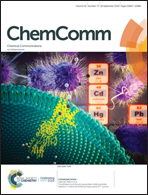Self-supported nickel iron oxide nanospindles with high hydrophilicity for efficient oxygen evolution†
Abstract
Engineering nanoarray structures with favorable hydrophilicity is proposed to unlock the electrocatalysis of NiFe2O4 for the oxygen evolution reaction (OER). The resulting electrode, consisting of NiFe2O4 nanospindles directly grown on FeNi3 foam, features enlarged active surface area, high hydrophilicity and increased electronic conductivity, which achieves superior OER activity and remarkable durability.



 Please wait while we load your content...
Please wait while we load your content...